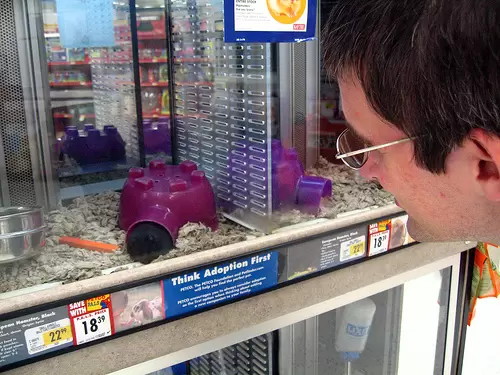Checking the Conditions
Firstly, you should check the conditions that the hamsters are being kept in by the pet store or breeder. Hamsters kept in good conditions will be happier and have less exposure to disease. Their cage should be clean with easy access to food and water, and should not be overcrowded.
Ensure that male and female hamsters are in separate cages and that the store staff or breeder seems certain of the sex of any hamster. This will ensure that you do not purchase a pregnant female.
Observing the Hamsters
Having found a suitable pet store or breeder that is keeping hamsters in good conditions, you will need to carefully observe and inspect the group. If any single hamster appears ill then the others may also be at risk of illness.
The hamsters should be alert and curious when awake, and not too nervous. This can be difficult to judge due to their nocturnal nature, but if necessary some very gentle prodding can be used to wake them up. It is best, however, to buy a hamster during the very late afternoon when they are more likely to be active. Observe their movement and ensure that they do not appear lethargic or reluctant to move around. Their bodies should be neither fat, nor skinny, while their coats should appear fluffy and smooth, with no bald patches or swellings.
Checking Your Hamster
A Syrian hamster can be expected to live for between 2 and 3 years, although they can sometimes live for 4 years.
Checking Your Hamster
Once you have selected a suitable, healthy-looking hamster, ask to handle it so you can check how tame it is and more closely inspect its appearance and health. If the seller will not let you handle the hamster then you will not be able to make these important checks and should avoid buying there.
You will want a hamster that reacts well to people. It is natural for them to be nervous initially but try to select a hamster that appears fairly calm when approached and is tame and friendly when handled. If possible, try to find out the age of your hamster. It is best to choose a hamster that is as young as possible, but it should be at least five to six weeks old.
Check that the hamster has a firm body and does not have runny, sticky or cloudy eyes, or a runny nose or sneezing. Also check the fur around the eyes, nose and chin. This should not be wet and there should be no signs of matted fur, staining or crusts. In addition, you should ensure that your hamster’s teeth are well aligned and not overgrown, and that there is no soiling or wetness around the rear end, which may be a sign of diarrhea.
Your hamster should breathe quietly and comfortably, without making wheezing, clicking or gurgling noises.
